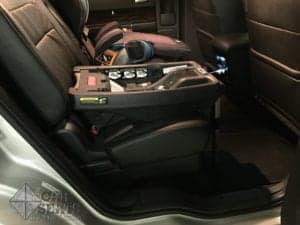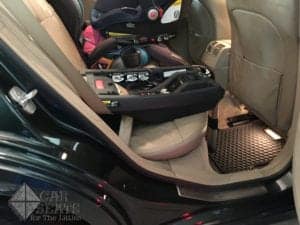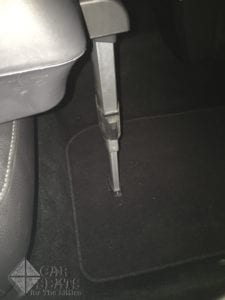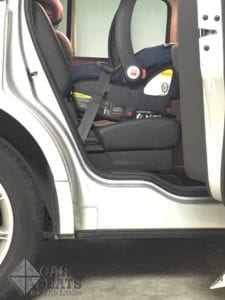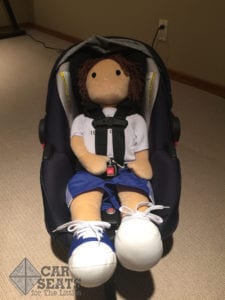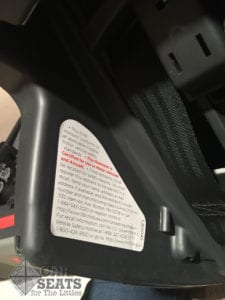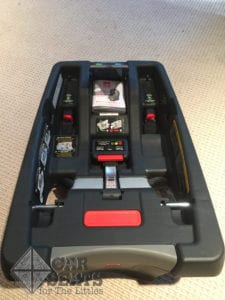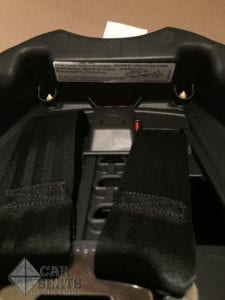The gb Asana has been on the market in the US for over a year now. But GoodBaby has made important updates to this rear facing only car seat, so it’s back in the hands of CSFTL for another review!
CSFTL Quick Stats
- Weight range: 4-35 pounds
- Lowest harness position: 5.5″ with the insert
- Height range: Less than 32″
- Expiration: Six years from the date on the sticker
- Handle position: Any locked position may be used in the car
Measurements
- Weight (carrier only): 8.2 pounds
- Shell height: 20″
Additional Version: gb Asana LTE
The LTE version of the seat, which comes as part of a travel system, is identical to the DLX, except that it does not have a load leg. The load leg can be purchased as an accessory for the LTE base. It’s currently available from gb customer service for $30 plus shipping and tax.
Features
One of the biggest changes is actually a removal of a feature, and that removal is an improvement. We don’t say that very often.
When the Asana was first released the harness and headrest moved together. As you tightened the harness, the headrest and straps came to rest below the child’s shoulders. Or, that was the plan. In reality, the harness was very hard to get properly positioned either below or even with the child’s shoulders.
The updated Asana has a more traditional no-rethread harness that suits both preemies and toddlers quite well. The harness tightens as expected, and the headrest adjusts the harness easily.
The base has the FirmFit arm lockoff and tensioning device which makes installing with a seat belt very easy. The FirmFit load leg is removable and optional. The load leg reduces rotation on the initial impact and reduces rebound after the crash. There shouldn’t be any need to remove it, it stores well under the base when not in use, but if necessary, it can be removed from the base completely.
The Asana includes a large insert that should be used for children who weigh between four and six pounds. The insert is optional for children who weigh six to 10 pounds. It’s such a large insert that I expect many smaller babies to need it, but it can probably be removed for most babies when they weigh around six pounds. It’s quite supportive, adds several inches under the bum of the baby, and has little wings that add support at the child’s hips.
Installation
Installation With the Base
The Asana’s base is very easy to install. Unlike other bases with tensioning devices, the FirmFit arm is easy to push down and lock into position. Like other seats with similar lockoffs, it’s easier to unbuckle the seat belt before you try to open the FirmFit. To install with the lower anchors, first remove the lower anchors from their storage places visible in the top of the base. While getting them out isn’t always a smooth and easy pull, their location is convenient because they’re not hidden somewhere where a parent may not see them. They don’t remove from the base, which means they’re permanently fixed at the belt path. The great thing about seats like this is that if a caregiver sees a twist, there’s an error. It’s not like other seats that can appear to have a twist or a bend even when perfectly straight. In the Asana, if there’s a twist, you need to redo it.
The base is just as easy to install with the seat belt as with the lower anchors. Route the seat belt through the open FirmFit arm, then remove the slack, and close the FirmFit. There is no need to lock the belt as the FirmFit arm acts as a lockoff. I’ve found that the FirmFit is easier to install and uninstall than many other tension based closures.
The base has an easy recline adjustment with a red button quite visible under where the child’s feet would be. The recline foot pops out, and even in my 2011 Mercedes E350 wagon’s steep backseat, the newborn recline is easy to achieve.
Using the FirmFit load leg takes a little getting used to, since it has three telescoping parts. Once I got used to the load leg, I found that I like it a little more than load legs on some other car seats. The Asana’s load leg can adjust to a locked position that’s just the right length, including spaces that are very short or tall. When it’s folded under when not being used, it folds flat and stays in its place. It’s not even noticeable.
The FirmFit arm has an easy to grip and open handle, opens wide, and indicates by changing from red to green when it’s fully closed and engaged.
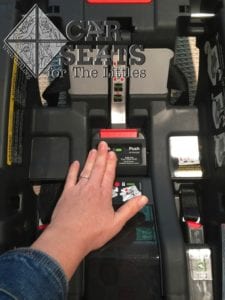
Installation Without the Base
Without the base, the installation is generally quite easy. The lap portion of the seat belt routes through the open belt guides on the seat itself, and I had no problems getting the seat snug. What did surprise me was the look of the seat when it was properly reclined. It looks more reclined than I had expected. The recline line is small, but clearly visible and not so low that the bolster of a vehicle seat may obscure it when installing. Though rolled towel can be used to help adjust the recline of the seat when installing baseless if necessary, I found the seat, even with its slightly awkward look, installed easily without a towel. The seat is also very very compact when installed without the base. This seat would be a good bet with or without the base for a back seat with limited front to back space, but without the base it’s remarkably compact.
Usage

The headrest and harness adjusts easily via this red loop at the top of the headrest.
I was pleasantly surprised to see that the Asana worked quite well for the preemie, newborn, and toddler dolls. My previous experience with the last generation of Asana was a mixed bag. The base was great to install, but the seat itself was quite hard to get snug enough and low enough for an average newborn. The new version, though, fit both the preemie and the toddler doll effortlessly. I’m so happy GoodBaby took feedback from clients and made such a large change to this central feature of their seat. The new version is so much easier to use properly.
To adjust the headrest now, you simply pull a tab at the top that allows the user to move the headrest and harness up or down as needed.
The harness width can be customized for different sized babies. There are small, medium, and large hip slots for babies, with no restrictions on when to use them other than what works best. This really helps the seat as children grow. The manual is quite clear on how to make adjustments and which slots should be used as changes are made.
Tightening and loosening the harness is as simple as I would expect it to be. Even with a no-rethread headrest and harness system there were no unpleasant surprises.
The seat clicks into and releases from the base easily. I have tiny hands, and I have no problem removing the seat from the base, unless the carry handle is at the head of the seat (and that’s an easy fix, just don’t put the handle there!). The base looks like a bowl ready to accept the seat; there’s no question as to how the seat needs to puzzle into the base, so there’s no extra movement of the child when trying to click the seat into the base.
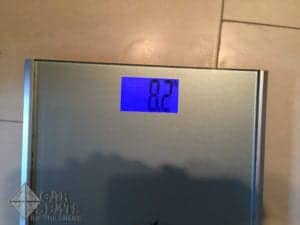
gb Asana: carrier weight.
The seat itself is a very lightweight 8.2 pounds. When carrying the base plus seat together (which most parents don’t do, but reviewers tend to move the pieces around together like this) it feels like most other seats. Each time I lift the carrier portion of the seat, I’m pleasantly surprised by how lightweight it is. The wide handle is another feature that makes the Asana comfortable for the caregiver. When it’s tucked into a caregiver’s arm, the carrier’s weight is spread more comfortably than the handles on most other rear facing only car seats.
Fit to Child
Preemie
I was kind of astonished at how well this seat fit my preemie doll. Even if the shoulder straps go low enough for a preemie, most car seats tend to be a little awkward in their fit elsewhere on the child. Maybe the crotch strap is too far away, or too long for a parent’s comfort, or the straps get tight enough but there’s room to spare at the hips. None of these are safety concerns, but that doesn’t mean they’re not parental concerns.
The Asana’s crotch strap has three positions, with the innermost being under the padding offered for babies who weigh four to six pounds. That innermost position shortened the crotch strap enough to fit the preemie doll. The hip straps fit snugly against the side of the doll and the shoulder straps fit nicely below the shoulders. The chest clip is also petite, which helps when trying to fit the smallest of babies. Even with the cushioned strap covers, the fit to the preemie doll was superb.
Newborn Doll

gb Asana, newborn doll without the infant insert
By simply removing the optional insert for babies over six pounds, the newborn doll fit perfectly. The insert is optional until the child weighs 10 pounds, but at seven pounds, the newborn doll doesn’t need the insert at all. The straps fit just as they should at hip, shoulders, and crotch.
4 Days Old

gb Asana 35 DLX: 4 days old
This wee model is just 4 days old! He weighs 7 pounds, 8 ounces and is 21 inches long. Using the lowest headrest position, inner crotch buckle and hip straps, the Asana DLX fits him well. He’s not using the infant insert.
Toddler
By raising the headrest, adjusting the hip straps wider, and moving the crotch strap out to the middle position, the seat was ready for a larger child. My 16 month old, 30″ child had not outgrown the seat by any of its limits. There was room above the head, and height and weight limits had not been reached. Combined with the lightness of the seat itself, this makes the Asana a nice option for parents who prefer to carry their child in the car seat for longer than the first several months.
Important Information: Where to Find
FAA Approval: The aircraft approval is on the bottom inside portion of the carrier part of the seat. The red sentence is clear and easy to read.
Manual Storage: The manual is stored in the base, on the top, below where the child’s head would be. There’s a storage compartment marked with the circled “i” for “information” that is easy to open and close and fits the manual well. The manual is also available at GoodBaby’s website, which is a nice option for a seat with the manual stored in the base. If the base is in the car and a caregiver has a question while they are in the house, the manual is available via the website.
Expiration: The six year expiration for the base and seat is listed on the sticker on the underside of the seat, under the child’s head area, above the harness. It’s tucked away, but once found, the sticker itself states quite clearly that the seat is good for six years.
Overall Thoughts
The updates to the Asana are exactly what the seat needed. The base is still easy to install with the lower anchors or the seatbelt. The biggest change has been to the seat itself: the Asana has been updated from a more complicated harness and headrest system to a more traditional no-rethread harness. The seat is far better for this change. The fit to children within the limits of the seat is ideal, no matter the size or weight of the child. The chest clip is nicely sized for infants and toddlers, and the insert used for smaller children does a remarkable job of helping without being too large.
GoodBaby generously provided the Asana 35 DLX used in this review. As always, the opinions shared here are our own!


